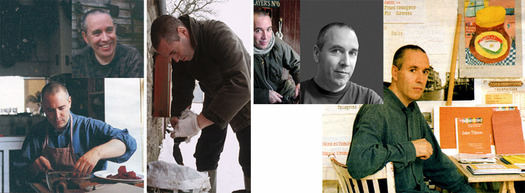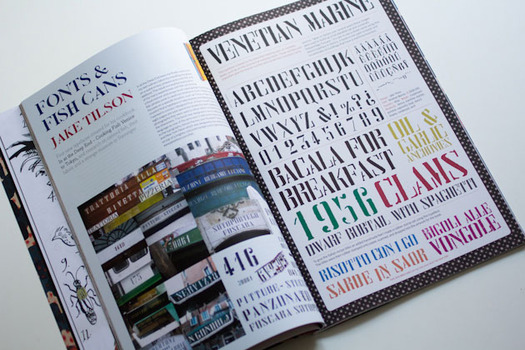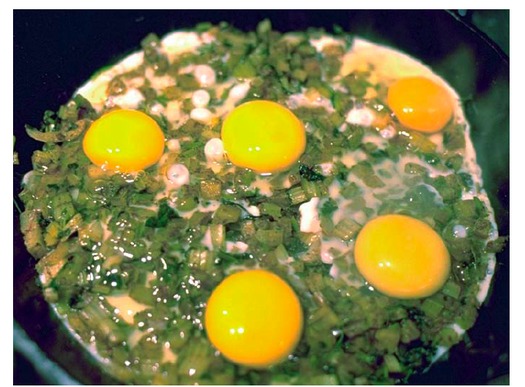
Image from jaketilson.com
Editor’s Note: This is the sixth installment of an eight-part series from Adam Harrison Levy about designers, artists and cooking. To see all the installments, click here.
Eggs hold the promise of new beginnings, but they can become boring: scrambled, fried, or hard-boiled, even fluffed into an omelet or drowned in a Benedict, their preparation can fall into a comforting, but limited, repertoire. Let Jake Tilson, a hybrid artist, designer, and cookbook writer, take you in a different direction at the start of this New Year.
Tilson is an expressive and deeply creative cook. Only in his global yet distinctively site-specific culinary universe can a breakfast of huevos rancheros, eaten in Los Angeles, inspire someone to cook Baid Masus, or Baghdad Special Eggs, a 13th-century Arab dish, in London.
What defines Tilson’s work in all media, including his cooking, is his appreciation and respect for the vernacular. The typography that he designs is inspired by local and site specific forms — such as overlooked lettering on bus tickets, plastic shopping bags, packaging or hand-painted signs. He synthesizes these influences into new designs. In his culinary explorations, he is similarly drawn to the local and the underappreciated.

Typefaces designed by jake Tilson for his recent cook book In at the Deep End. (Image via We Made This)
A few years ago, The South London Gallery, just down the street from where Tilson lives, commissioned him to make a work based on the concept of independence. His response to this artistic challenge was to interpret it in culinary terms. Steeped in the debate surrounding the making and distribution of food, he chose to examine the neighborhood aspect of independence; he would make a meal, served at the gallery, but “sourced exclusively from local independent shops — no chain stores.”
South London is a polyglot neighborhood, with ethnicities ranging from West African to Pakistani to Turkish. Tilson began to shop in out-of-the way one-off stores and the small localized markets, as well as in the larger, more organized shops catering to the community population. “To shop in an exploratory, unplanned fashion was liberating,” he later wrote.
In his neighborhood there is a store called Persepolis, which is a mecca for the local Iranian, Iraqi, Syrian, Lebanese, Egyptian and Turkish communities. For the “Independence” project, many of the dishes Tilson made were inspired by a single ingredient found in local stores, such as ogbono or fufu flour.
But for this dish, he decided to try something entirely different. In order to spark a culinary conversation about issues of conflict and nationality, he did some historical research to guide his local shopping. To that end, he found a book called Medieval Arab Cooking, a translation of the Kitab al-Tabikh, written by al-Baghdadi circa 1200 and translated into English in 1939.
Having recently returned from Los Angeles, where he had breakfasted on superior huevos rancheros, Tilson was inspired to cook a medieval Arab dish that is essentially eggs sitting on a bed of spicy onion and celery. He served it in the gallery accompanied with flatbread and a spicy merguez sausage. It was, he says, “the perfect Middle Eastern brunch.” Happy New Year.

Image courtesy of Jake Tilson
Baghdad Specil Eggs (Baid Masus)
Beid (Baid) = egg
Masus = Special
Makes 6 servings
INGREDIENTS:
3 tablespoons olive oil
1 teaspoon sesame seeds
4 large celery stalks, finely chopped
2 cups fresh coriander, chopped
1 teaspoon ground cumin
1/2 teaspoon cinnamon
1 teaspoon wine vinegar
several saffron threads
a pinch of salt
6 eggs
ACCOMPANIMENT:
I serve it with spicy merguez sausages and flatbread.
INSTRUCTIONS:
1) To make sesame oil, heat olive oil in a pan, add the sesame seeds and lightly fry for a few minutes.
Allow to cool, then sieve out the seeds.
2) Pour a little sesame oil into a wide frying pan. When it's hot, add the celery and cook until transparent.
Add the coriander, cumin, cinnamon, wine vinegar, saffron and salt. Stir well and cook for a further 2
minutes.
3) Spread the mixture evenly across the base of the pan, then break the eggs carefully over the mixture,
leaving them whole. Cover the pan and cook slowly.
4) When cooked, remove from heat, leave to cool a few minutes, then cut into wedges.
From Jake Tilson's A Tale of 12 Kitchens, published by Artisan, 2006.
A version of this article originally appeared on Gourmet Live!

